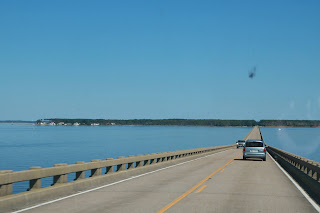Tuesday, October 6
Fifty-four degrees this morning. We have breakfast tacos with sausage before continuing the drive east. We stop at a laundromat outside of Raleigh and do a major wash with all the bedding and clothes. They have large capacity machines, so it doesn't take too too long and we are back on the road by 11:15.
We've decided to head for the coast and call ahead to make two reservations at the National Seashore Campsites at Oregon Inlet and Cape Hattaras. We are on highway 64, which moves right along through flat farmland with cotton, soybeans, sweet potatoes and sleepy small towns. No more mountains and clear skies.
We stop at an Outer Banks Visitor Center in Tyrell County. Nice lady with mask, behind plexiglass gives us some maps and brochures. The Outer Banks starts a bit north of us, but we did a family vacation up there near Kitty Hawk, so decide to begin this venture on Roanoke Island and head south.
This is the old bridge into Roanoke (through a dirty windshield). The new one, called 5 Mile Bridge by the locals and Virginia Dare Bridge on the map, is a bit south of this one. Virginia Dare is known as the first English child born in North America on August 18, 1587. She was born in Roanoke Colony. No one knows what happened to her or the colony, as John White, the governor of the colony returned to England for supplies and when he came back three years later there was no sign of anyone.
Since it is still relatively early, we stop at the North Carolina Aquarium. We purchase tickets for 2:00 on line. (They are limiting numbers of people by selling timed tickets.) Nice aquarium, not huge, but interesting displays including holographs. Lots of reminders to keep distance and wear masks and it isn't very crowded. Everyone complies except for a few excited children.
Nice sea otter display.
A sea turtle area had several injured turtles being taken care of, including a 170 pound loggerhead.
As do sharks. This area is known as the Graveyard of the Atlantic and there was information and displays about wrecks that became teeming reefs.
The Turret Theater showed a short film about the battle of the Monitor and the Merrimack, two ironclads during the civil war. (No seating available.) They fought for hours but couldn't sink each other and left the area, and in typical fashion, both claimed victory. The Monitor later sank in a storm and was only found in 1973.



















I've never been there but heard so much from friends who have; it looks just beautiful. Thanks for these pictures!
ReplyDelete